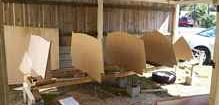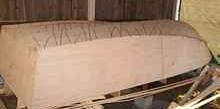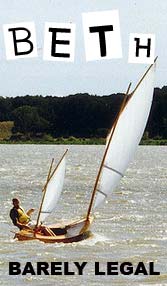| To
Part Two
To Part Three
 |
The initial hand drawn sketch, that I drew,
of the Mangrove Jack. |
Part One
Last year the better half and I decided that we would get a camper
trailer and a small car topper. We both enjoy camping and fishing,
so this was a logical step for us. The camper was sourced from
E-bay secondhand, then the hunt for a boat, this terminated with
the purchase of a Seacraft Ranger 3300. This is a nice little
punt for VERY protected water, but did not handle the Burrum River
or the local North Pine, even in moderate conditions. This was
a safety issue and so the Ranger has been sold.
The answer to me was a V-Nose punt. I considered designing it
myself, but lack the expertise. So seeing a couple of articles
by Mark Bowdidge, I rang him and discussed my concept. Mark was
very helpful and I visited him and his partner Debbie, with a
very rough sketch of what I was after. The criteria here was a
stable, lightweight boat which will handle a bit of slop and carry
three adults in safety.
 |
Parts cut out |
Several weeks later (Mark had other designs on the board to finish),
and several phone calls, for consultation on the design (not to
harass the designer), the initial line drawing was sent to me.
The hull was actually a V configuration with modified chines,
this will allow it to sit right way up on the camper's racks,
as I carry the Flip'n' Easy trailer and fishing gear in the boat
when travelling.
 |
Frames setup |
The plans finally arrived and I went out and started buying the
plywood (Pacific Maple), epoxy resin, fibreglass cloth, glue powder,
micro balloons and bits and pieces. The boat only requires 7 x
6mm and 1 x 9 mm sheets of Ply, plus two sheets of MDF or chipboard
for temporary frames, as it is stitch and glue construction.
The building stock has been built levelled, and squared up, and
I have commenced cutting out the panels, and the four temporary
frames. I have still to loft and cut out the two bottom and two
side panels, for these panels, I have scarf jointed the four sheets,
from which they and three smaller bulkheads and panels will be
cut, This has taken a total of about 15 hours so far, with an
estimated 40-45 hours to finish.
 |
All stitched up |
One week later the side and bottom panels are cut out, and all
is ready to start assembly. Assembly started and the boat went
from a set of temp frames and panels to a hull in one day, as
can be seen in the pictures assembling the hull is fairly straight
forward, as long as you have measured and cut accurately. Pulling
the bow sections into alignment was interesting, but I later find
out that the Pacific Maple I am using, is somewhat stiffer than
the Gaboon Ply specified in the plans.
Next week the intention is to do some work at my daughter's and
turn the boat over and start filleting the joins etc.
 |
Glued and ties removed |
Mangrove
Jack design by Mark Bowdidge is available at Duckworks.
*****

|



